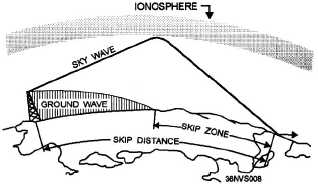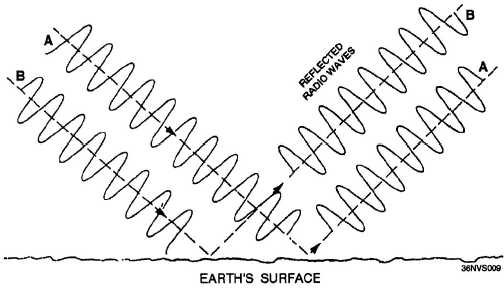SKIP DISTANCE AND ZONE
Recall from your previous study that a
transmitted radio wave separates into two parts,
the sky wave and the ground wave. With those
two components in mind, we will now briefly
discuss skip distance and skip zone.
Skip Distance
Look at the relationship between the sky wave
skip distance, skip zone, and ground wave
coverage shown in figure 1-8. The skip distance is
the distance from the transmitter to the point
where the sky wave first returns to the earth. The
skip distance depends on the wave’s frequency and
angle of incidence, and the degree of ionization.
Figure 1-8.—Relationship between skip
zone, skip distance, and ground wave.
Skip Zone
The skip zone is a zone of silence between the
point where the ground wave is too weak for
reception and the point where the sky wave is first
returned to earth. The outer limit of the skip zone
varies considerably, depending on the operating
frequency, the time of day, the season of the year,
sunspot activity, and the direction of transmission.
At very-low, low, and medium frequencies, a
skip zone is never present. However, in the high-
frequency spectrum, a skip zone is often present.
As the operating frequency is increased, the skip
zone widens to a point where the outer limit of the
skip zone might be several thousand miles away.
At frequencies above a certain maximum, the
outer limit of the skip zone disappears completely,
and no F-layer propagation is possible.
Occasionally, the first sky wave will return to
earth within the range of the ground wave. In this
case, severe fading can result from the phase
difference between the two waves (the sky wave
has a longer path to follow).
REFLECTION
Reflection occurs when radio waves are
“bounced” from a flat surface. There are basically
two types of reflection that occur in the
atmosphere: earth reflection and ionospheric
reflection. Figure 1-9 shows two
Figure 1-9.—Phase shift of reflected radio waves.
1-7



